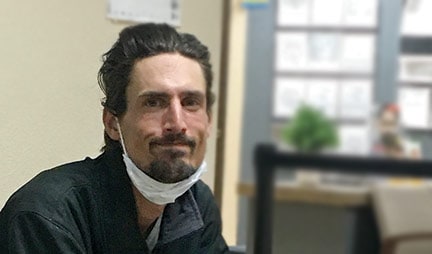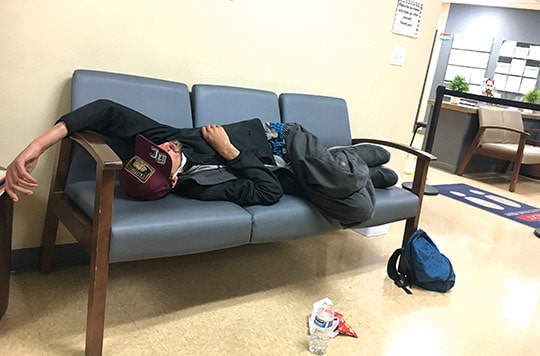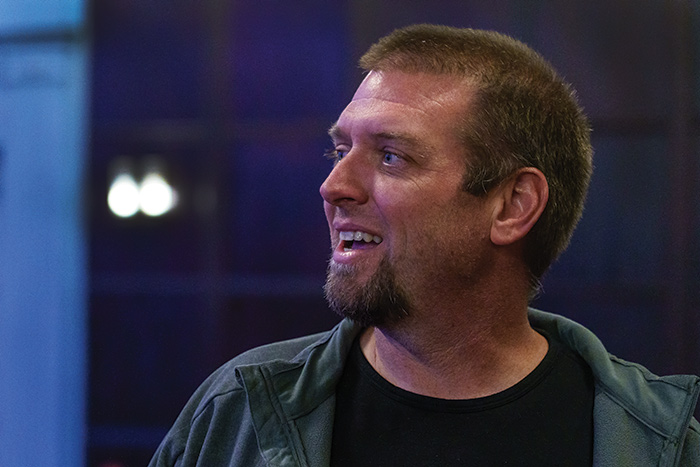Living in fear for your son’s life

Per Dahlin lives in a constant state of vigilance, ever fearful her son is going to die.
“I always feel like that,” said the 60-year-old Claremont resident and mother of three. “Particularly in these last few months where he’s been so terrible and really spiraled.
“It just feels like your child is dying all the time.”
That child is 31-year-old Samuel Kraemer-Dahlin, known to the many who love him as Sam.
Sam has been addicted to heroin and methamphetamine for about six years. Over that time he’s lived mostly on the streets, and has been in and out medical and psychiatric hospitals, as well as sober living and rehab facilities, more than 50 times.
He’s also suffered through a life-threatening bout with fungal meningitis, and has had several bilateral strokes, a rare event that can occur from multiple strokes on both sides of the brain or a unique instance where a stroke in one hemisphere affects the other.
And Sam has made dozens of appearances in the COURIER’s Police Blotter over the past couple of years, all for petty crimes and drug possession.
Those arrests, and Sam’s frequent mentions in the Blotter (though as a “31-year-old unhoused man,” as the COURIER’s policy is to not use names for unhoused people), prompted several letters to the editor from supporters who were dismayed about our coverage of Sam, which they contended was exploitative, in the June 11 edition of the COURIER.
Those letters also led the COURIER to Sam’s mother, who, for the record, asked us to use her son’s name in this story.
The Kraemer-Dahlin family moved to Claremont when Sam was a toddler. A product of Claremont schools—Sycamore, El Roble Intermediate and Claremont High—his childhood was happy.
“He was a very tender child,” Ms. Dahlin said. “It sounds like our family was really sad, but we were actually a really happy family. We were weird, a little different, but we were happy. We did a lot of fun things.”
Sam’s two sisters, one older and one younger, also wound their way through Claremont schools.
Older sister Sophia, 35, is a poet. She lives in Oakland and just had her first book, “Natch,” published by City Lights.
His younger sibling Rowan, 30, is starting graduate school in New York City in the fall.
Sam’s fall—from a well-liked, sweet and charismatic teenager to unhoused, mentally-ill drug addict—was gradual. It seems to have begun around high school, when he began acting out with alcohol. But what presented as “garden variety” rebellion, as his mother put it, in fact ran much deeper.
“He has severe ADHD, which wasn’t discovered until he was in high school,” Ms. Dahlin said. “He was not medicated. We were worried about medication.”
In in the early 2000s, Claremont Unified School District accommodations for kids suffering with ADHD, anxiety and depression were nowhere near as robust as they are now.
“People kind of cobbled their own accommodations together,” Ms. Dahlin said. “He had a lot of teachers who worked hard to help him. And part of that was he’s a sweet kid. They wanted to help him.”
It wasn’t easy, but Sam graduated.
After that, things began to unwind. He found purpose for a while, living with a girlfriend and throwing himself into various projects. He travelled to Uganda to help with Buiga Sunrise, a nonprofit that ran a school and clinic there. He took part in other projects in Iceland and Spain as well.
But Sam just couldn’t seem to keep anything organized, his mother said, and that contributed to his waning interest in the various endeavors.
“We were thinking, ‘This kid is having a really hard time growing up,” she said.
Back in the states, things looked up for time after he fell in love with a young first-generation Cambodian-American woman who lived in Pomona.
“She was wonderful, and she stuck with him through some tough stuff,” Ms. Dahlin said. “He had two good years, but eventually he fell into heroin use. At that point, everybody that we reached out to said you’ve just got to be harsh and say ‘No, we can’t enable you.’ She was good. She was loving and firm and she said no.”
That was six years ago.
Since then, Ms. Dahlin, her husband of 37 years, and their children have all suffered alongside Sam.
“He was on the streets, and it was a really awful time for the whole family,” Ms. Dahlin said. “And it was awful for him too. When I would find him, he would be emaciated, filthy, sad.
“I know every alley in Pomona. I know every corner. I know where all the drug deals happen.”
One night, Ms. Dahlin found him passed out under a dumpster.
“He caught fungal meningitis, probably from sleeping under dumpsters,” Ms. Dahlin said. “There’s stuff under there, and if your immune system is shot because you’re using heroin and you’re hungry, then your body can’t fight it.”
He ended up in Pomona Valley Hospital Medical Center’s ICU, fighting for his life. And then as the doctors struggled to get a handle on the meningitis, Sam had multiple bilateral strokes.
“Who knows, he may have had some before he got into the hospital. We don’t know. But the doctors said there was a lot of damage,” Ms. Dahlin said. “They didn’t think he was going to make it. Nobody thought he was going to make it.”
It’d been a pretty horrible year-and-a-half prior the meningitis and strokes, Ms. Dahlin said.
“And we sort of felt like, ‘Is he gonna live? If he lives, he’s got another chance.’ There’s that crazy hope. You can’t undo the past, but you can really start clean.”
Sam spent two months in the hospital and another month in a rehab facility learning to talk, walk, and dress himself. His family hoped the trauma he’d endured would somehow push him to want to get clean.
But he was using again and back on the streets sometime shortly before the pandemic hit in March 2020. Since then he’s been arrested dozens of times for breaking into cars and various petty thefts, all in an effort to fund his addiction.
Ms. Dahlin remains strong, open to the goodness in the world. She credits Nar-Anon, the 12-step program for family and friends of addicts, as having been a tremendous help to her and her husband.
“I’m in several Nar-Anon groups,” she said. “And I see people all the time that I talk to who probably should be going to Nar-Anon because it’s so helpful. It’s just everywhere. And he’s not the only kid in his class. We know lots of people whose kids have died.”
She went on to praise the Claremont community that has rallied around her family, including Sam.
“So that’s why I think people wrote to you about the Police Blotter,” she said. “They see him. They know him. And that’s why I said, ‘use his name.’”
These days Ms. Dahlin allows herself hope, but it’s not the same as it once was.
“A lot of times the only thing that I hope for is he’s not suffering,” she said. “I know that sounds awful. I should be saying I hope he doesn’t break into any more cars, or, oh my gosh I hope he doesn’t leave needles on the driveway any more.
“But I see so much suffering in him. Why does he carry so much? There’s that concept of the whipping boy … Why does this child—because he is like a child; he’s not at all like an adult—why is this child carrying so much?”
Go to https://www.nar-anon.org for information on a meeting near you.
Our reporter’s opinion on covering this story
Many, if not most of the folks I write about in the COURIER’s popular Police Blotter feature are addicted to drugs. Many are unhoused, and all of them have been arrested for some sort of alleged crime.
Methamphetamine is the overwhelming favorite these days among the Blotter’s drug users, but heroin seems to be coming up strong right behind it as the drug of choice for our down and out brothers, sisters, sons and daughters.
I have always endeavored to be kind, and I’d never kick someone when he or she is at their lowest. You would not believe the sad and terrible things I choose not to write about in the Blotter, for these very reasons.
But I don’t always get it right.
On June 4 I wrote flippantly about a 31-year-old unhoused man who has made dozens of appearances in the Blotter over the past couple of years, all for petty crimes and drug possession.
The next week, the COURIER received several letters of complaint from people who know and love this man—including his mother—each objecting to the dismissive tone of my writing.
And I agree with them. I know I can, and should, do better.
Each of us has moments of weakness. We humans make mistakes. My grandfather always told me it’s what you learn from those shortcomings and lapses in judgment that matters most.
Claremont, with its historic architecture, leafy streets and world-class colleges, is still a small suburban town. People have connections that go back generations, and for better or worse, word travels fast here.
What I choose to write about in the Blotter, and how I write about it, can wound, especially here, where secrets are hard to keep.
So with humility I plan to do better.
One thing that has changed is I think three times before injecting humor into a Blotter entry. And that’s good. It’s good to be humbled. It’s good to remember that I got into journalism to do good, not harm.
Another positive by-product of those unhappy readers’ letters is I connected with this man’s mother, Per Dahlin, an incredibly strong and gentle woman, who trusted me to tell her son’s story. That story is part of this issue of the COURIER.
My hope is by talking openly about the “wounded walkers among us,” as Ms. Dahlin put it, we might learn a little about kindness without judgement, and in turn help chip away at the lingering stigma surrounding drug addiction and mental illness.
It’s a good start, anyway.
by Mick Rhodes | mickrhodes@claremont-courier.com









0 Comments